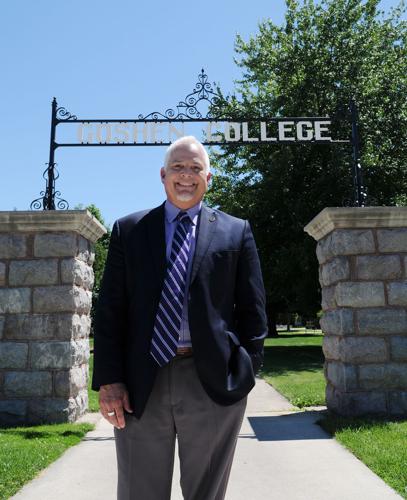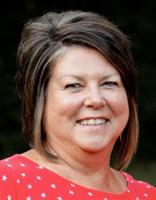GOSHEN — It’s the quiet time of year at Goshen College.
As Jim Brenneman walked the campus he calls home earlier this week, he used that silence to reflect upon his time as the college’s 16th president.
From the moment he took the reins as Goshen College president 10 years ago today, Brenneman, 61, began shifting the focus toward creating a more diverse student population.
“We, as an institution, are significantly different in who we are than we were 10 years ago,” Brenneman said.
Initially, Goshen College served as a training grounds where like-minded Mennonite students gathered to learn and grow together before being sent across the globe to share their teachings, he explained.
“But what happens when the world moves to your door? We have tried to create a ‘World House of Learning’ by not only continuing to send our students all over the world, but also in making sure our campus looks more like the world than not.”
College leaders, Brenneman included, began discussing ways to diversify the college’s delivery systems — altering the general education curriculum to meet the needs of 21st century students, seeking ways to offer first-generation and minority students an opportunity to attend college for an affordable price and extending learning methods beyond the traditional models.
At the same time, Brenneman remained focused on another of his goals — to re-energize and reconnect Goshen College as an institutional anchor in the community and not as “that college at the end of Eighth Street,” he said.
“When I first came I said “the world needs Goshen College” and I believed it deeply,” he said. “But it is equally true that we need the community. We need the world. We need the people of Elkhart County. We need to feel part of one community.”
David Daugherty, president of the Goshen Chamber of Commerce, said Brenneman has served as a great partner for the chamber and business community.
“He really has been a unifying force in Goshen for many, many years,” Daugherty said.
From supporting the Intercultural Leadership Class, Brenneman has helped bridge the gap between the community and the Hispanic community while building relationships across many local boards and organizations, Daugherty said.
It’s a change Brenneman said he has noticed as well.
“I’ve seen a change in the town of Goshen over these 10 years and it’s because we’re all working together,” he said. “We’re really becoming what I’d call a thriving college town. And I would say 10 years ago we weren’t quite there and 10 years from now we’re even going to be grander and better.”
Diversity
Although the college maintains its deeply rooted connection to the Mennonite tradition, less than half of today’s Maple Leafs are of the Mennonite faith.
According to college data, 36.8 percent of students identify as Mennonites, followed by 17.3 percent Conservative Protestant and 12 percent Catholic.
After a decade of focus on embracing interculturalism, Goshen College has begun to reflect the diversity of the local community, Brenneman said.
“We’re beginning to reap what we have sowed the past 10 years in positive ways. We’re being asked to speak at national conferences on how we transformed a small, Midwest college in the middle of nowhere from their point of view, into an intercultural dynamo.”
Last year’s incoming class included record-breaking 28 percent of Hispanic students, setting the college on track to achieve another of Brenneman’s goals — to become federally recognized as a Hispanic-Serving Institution.
Hispanic-Serving Institutions are accredited, degree-granting, public or private nonprofit higher education institutions with Hispanic student enrollments of 25 percent or higher.
According to college data, approximately 15.6 percent of the 839 students enrolled during the 2015-16 school year were Hispanic.
Of the entire student body, 38 percent are intercultural or international students, Brenneman said, adding that he hopes to see that percentage reach the 50 percent mark within the next three or four years.
“We’re on a positive trajectory to fulfill that dream of having Goshen College be representative of the world in which we’re a part,” he said.
Campus
From a physical perspective, today’s Goshen College campus looks very similar to the campus Brenneman and his family strolled through after he was tapped to lead the college in December of 2005. Brenneman and his wife Dr. Terri J. Plank Brenneman have one son, Quinn, 19.
The second portion of a two-part student apartment complex has been completed, an underpass added beneath the railroad tracks that split the 135-acre campus and improvements to common spaces such as cafeterias and classrooms blend into the historical buildings and green space.
Goshen College’s footprint also encompasses the 1,189-acre Merry Lead Environmental Learning Center, located 31 miles away from its Goshen campus in Wolf Lake, Indiana.
While college leaders continue to develop future master plans for the college’s growth, large-scale dormitories or new buildings aren’t likely to appear on the to-do list, Brenneman added.
“We have a fairly large footprint for the number of students we have,” he said. “So for us to invest a lot of money in building more buildings when we have sufficient building space for up to 1,500 students — and we’ve never had that many students — isn’t a priority.”
Instead of adding new buildings, school leaders direct their spending toward becoming more efficient.
During Brenneman’s tenure, college leaders returned about 12 acres of campus back to native plant life — one small part of an initiative to create a greener college.
In the spring of 2007, Brenneman became one of the first college presidents in the country to sign the American College and University Presidents Climate Commitment, now known as the Carbon Commitment, agreeing to neutralize the campus’s greenhouse gas emissions.
Today, more than 700 monitors on campus help officials track the use of electricity. The boiler system has been exchanged, converted to a geothermal system instead.
“Our entire campus is non-carbon based systems. None of our electricity is produced using coal,” Brenneman said.
Challenges
Serving as the progressive leader of a more than 120-year-old college rooted in the Anabaptist tradition has not been without its challenges.
In January 2010, members of the president’s council announced they had decided to allow the athletic department to play an instrumental version of the national anthem during sporting events.
The decision was met with some concern from alumni, many who felt the song’s references to war did not align with the college’s theology.
Some Mennonite schools had played the anthem for years, but Goshen wasn’t among them.
“I thought the time had come particularly because we are diversifying our student body,” Brenneman explained. “In some ways what really drove it was we had more and more Latino students whose families were coming into citizenship and for many of them it was like the sign of having arrived. They viewed it very differently than some of our own alumni.”
After more than a year of discussion with alumni and the community, Brenneman in August 2011 announced a compromise — the first verse of “America the Beautiful” would instead be played or sung with the U.S. flag present.
The second controversy came last year as college leaders considered extending its non-discrimination hiring policy and offering same-sex married couples the same benefits as other employees.
“I would say both issues for me, as president, were similar in that you could make arguments for being more welcoming and inclusive,” Brenneman said. “All of the arguments that were made for each of them were almost identical. You could just take the issues out.”
Although Brenneman’s leadership was tested during the controversies, Goshen College board chair Conrad Clemens said he remained dedicated to creating the best opportunity for the college and its faculty and students.
“Jim has done a really great job of listening to all sides,” Clemens said. “In a time of radical change in the landscape of higher education and the need to not only thrive, but even at times to survive, has required really strong leadership and I think that Jim has done a superb job of sharing that message with constituents who may not see the need for that change.”
Clemens, who attended Goshen College from 1981 to 1985 and has served on the board for more than four years, said he has been impressed with Brenneman’s ability to lead the college and diversify its student body.
However, attracting new students continues to be the top priority — and the biggest challenge — for college leaders.
Enrollment
“Enrollment still is a huge issue for us going forward. That’s why we had to change how we go about doing things and changing how we embrace others,” Brenneman said.
During the 2009-10 school year, enrollment at Goshen College peaked at 1,012 total students — the highest since the early 1980s.
“And then the economy fell,” Brenneman said. “We’ve been fighting back ever since.”
Although more diverse, last year’s class of 839 was smaller than the each of the previous five years, according to college data.
At the same time as enrollment dropped, so too did the college’s endowment, Brenneman added.
The endowment lost nearly $40 million.
“Nowadays small college and more and more public institutions have to do a lot of fundraising and I think there’s been no question that that’s been part of what we do here,” Brenneman said.
Over the last 10 years, just under $70 million has been raised and as of July 2015, the Goshen College endowment was $110,475,554.
According to college data, the annual cost for operating expenses is approximately $36 million.
The changing landscape of education has also affected the college’s finances, Brenneman added.
With access to dual-credit courses that can be taken for college credit, more high school students are arriving on campus as “froshmores” and completing their degrees sooner, he said.
“In the past you could almost count on students being here for four years,” Brenneman said. “... but that’s not the case anymore.”
In response, college leaders have begun expanding online course offerings, simplifying the transfer process and are in discussions with local businesses — including the healthcare industry — to find ways to offer students credentialing they need to enter the workforce.
Yet when asked about the long-term viability of the college, Brenneman said he’s confident about the future.
“But that doesn’t mean we can rest on that fact. We really do have to increase our enrollment,” he said. “Enrollment continues to be the number one strategic priority of the Goshen College board and administration going forward. No doubt, no question.”
Follow Julie on Twitter @jbeer_tgn














